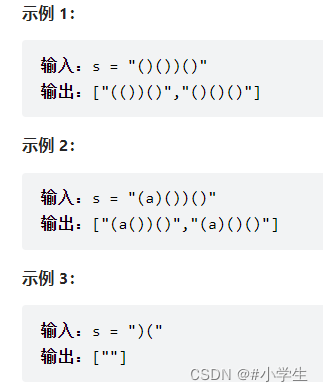-
LeetCode301:删除无效的括号
要求
给你一个由若干括号和字母组成的字符串 s ,删除最小数量的无效括号,使得输入的字符串有效。
返回所有可能的结果。答案可以按 任意顺序 返回。

要求
方法:DFS 实现回溯搜索+剪枝
首先我们令左括号的得分为 1;右括号的得分为 −1。则会有如下性质:- 对于一个合法的方案而言,必然有最终得分为 0;
- 搜索过程中不会出现得分值为 负数 的情况(当且仅当子串中某个前缀中「右括号的数量」大于「左括号的数量」时,会出现负数,此时不是合法方案)。
可以预处理搜索过程的最大得分: max = min(左括号的数量, 右括号的数量)
出现字符分三种情况:
- 左括号:如果增加当前 ( 后,仍为合法子串(即 score + 1 <= max) 时,我们可以选择添加该左括号,也能选择不添加;
- 右括号:如果增加当前 ) 后,仍为合法子串(即 score - 1 >= 0) 时,我们可以选择添加该右括号,也能选择不添加;
- 普通字符:直接添加。
使用 Set 进行方案去重,我们可以通过预处理,得到最后的「应该删除的左括号数量」和「应该删掉的右括号数量」,来直接得到最终的 len;考虑增加一层剪枝;
这里代码注释我也不能保证百分百准确,每个人理解的都不一样class Solution { Set<String> set = new HashSet<>(); // n:字符串长度;max:最大括号数(单括号):maxPathLen:记录搜索过程中的最大路径子串的长度 int n, max, maxPathLen; String s; public List<String> removeInvalidParentheses(String s) { n = s.length(); int left = 0, right = 0; // 统计多余的括号数量 for (char c : s.toCharArray()) { if (c == '(') left++; else if (c == ')') { if (left != 0) left--; else right++; } } maxPathLen = n - left - right; // 提前更新 maxPathLen // 统计左右括号数量 int left2 = 0, right2 = 0; for (char c : s.toCharArray()) { if (c == '(') left2++; else if (c == ')') right2++; } max = Math.min(left2, right2); dfs(0, "", left, right, 0); return new ArrayList<>(set); // 将Set集合转为List返回 } /** * 遍历 _s 字符串,记录有效路径 * @param curCharIndex 当前遍历的字符下标 * @param path 遍历时的路径(括号组合字符串) * @param left 多余的左括号数量 * @param right 多余的右括号数量 * @param score 分数,用于标记左右括号的得分 */ private void dfs(int curCharIndex, String path, int left, int right, int score) { // 剪枝:合法路径的得分范围为 0 <= score <= max;多余的括号数量为负数,说明删多了,不符合 if (left < 0 || right < 0 || score < 0 || score > max) return; if (left == 0 && right == 0) { // 多余的括号为0,且当前路径长度等于最大路径子串的长度,则符合 if (path.length() == maxPathLen) { set.add(path); } } if (curCharIndex == n) return; // 搜索完毕,退出(放在此处是为了记录完最后一个字符) char c = s.charAt(curCharIndex); // 获取当前字符 // 每一种选择都对应 添加/不添加 if (c == '(') { // 添加左括号,score + 1;不添加score不变,多余的左括号数量-1 dfs(curCharIndex + 1, path + c, left, right, score+ 1); dfs(curCharIndex + 1, path, left - 1, right, score); } else if (c == ')') { // 添加右括号,score - 1;不添加score不变,多余的右括号数量-1 dfs(curCharIndex + 1, path + c, left, right, score - 1); dfs(curCharIndex + 1, path, left, right - 1, score); } else { // 普通字符,score不变 dfs(curCharIndex + 1, path + c, left, right, score); } } }- 1
- 2
- 3
- 4
- 5
- 6
- 7
- 8
- 9
- 10
- 11
- 12
- 13
- 14
- 15
- 16
- 17
- 18
- 19
- 20
- 21
- 22
- 23
- 24
- 25
- 26
- 27
- 28
- 29
- 30
- 31
- 32
- 33
- 34
- 35
- 36
- 37
- 38
- 39
- 40
- 41
- 42
- 43
- 44
- 45
- 46
- 47
- 48
- 49
- 50
- 51
- 52
- 53
- 54
- 55
- 56
- 57
- 58
- 59
- 60
- 61
- 62
- 63
- 64
- 65
- 66
- 67
时间复杂度:预处理 max 和 len 的复杂度为 O(n);不考虑 score带来的剪枝效果,最坏情况下,每个位置都有两种选择,搜索所有方案的复杂度为 O(2^ n );同时搜索过程中会产生的新字符串(最终递归树中叶子节点的字符串长度最大为 n,使用 StringBuilder 也是同理),复杂度为O(n)。整体复杂度为 O(n * 2^n)
空间复杂度:最大合法方案数与字符串长度呈线性关系。复杂度为 O(n)
简化:从前往后删除多余右括号,从后往前删除多余左括号
public class LeetCode301 { public List<String> removeInvalidParentheses(String s) { int n = s.length(); Set<String> set = new HashSet<>(); dfs(s,set); //空的返回空字符串集合 if (set.isEmpty()){ set.add(""); } return new ArrayList<>(set); } private void dfs(String s, Set<String> set) { //从左往右删除多余的右括号 int count = 0; for (int i = 0; i < s.length(); i++) { char c = s.charAt(i); //count计数,左括号+1,右括号-1; if (c == '('){ count++; } if (c == ')'){ count--; } //count<0说明右括号富裕了,进行剪枝 if (count < 0){ for (int j = 0; j <= i; j++) { //除第一个字符是'('时,遍历到j位置的前一个字符就是右括号,进行下个for循环,不行下面的语句 if (j > 0 && s.charAt(j-1) == ')'){ continue; } //如果当前位置就是右括号,剪枝,递归 if (s.charAt(j) == ')'){ //创建s字符串对象,可变的,deleteCharAt(j)删除当前索引位j的字符 dfs(new StringBuilder(s).deleteCharAt(j).toString(),set); } } return; } //遍历到最后一位并且符合有效的括号,在进行添加返回 if (i == s.length() - 1 && count == 0){ set.add(s); return; } } //从右往左删除多余的左括号 count = 0; for (int i = s.length() - 1; i >= 0; i--) { char c = s.charAt(i); if (c == '(') count --; if (c == ')') count ++; //count < 0,说明左括号富裕了,进行剪枝 if (count < 0){ for (int j = s.length() - 1; j >= i; j--) { //除最后一个字符是'('时,判断当前位置的下一个字符是否是'(',进行下次循环 if (j < s.length() - 1 && s.charAt(j + 1) == '('){ continue; } if (s.charAt(j) == '('){ dfs(new StringBuilder(s).deleteCharAt(j).toString(),set); } } return; } //遍历到首位,如果符合有效括号 if (i == 0 && count == 0){ set.add(s); return; } } } }- 1
- 2
- 3
- 4
- 5
- 6
- 7
- 8
- 9
- 10
- 11
- 12
- 13
- 14
- 15
- 16
- 17
- 18
- 19
- 20
- 21
- 22
- 23
- 24
- 25
- 26
- 27
- 28
- 29
- 30
- 31
- 32
- 33
- 34
- 35
- 36
- 37
- 38
- 39
- 40
- 41
- 42
- 43
- 44
- 45
- 46
- 47
- 48
- 49
- 50
- 51
- 52
- 53
- 54
- 55
- 56
- 57
- 58
- 59
- 60
- 61
- 62
- 63
- 64
- 65
- 66
- 67
- 68
- 69
- 70
- 71
- 72
- 73

-
相关阅读:
实在智能AI+RPA:引领数字化转型的超自动化智能体
SpringBoot @Scheduled注解(cron、fixedRate、fixedDelay、initialDelay)各个参数区别
将 Python 项目打包成可输入参数的exe可执行文件
图像&视频编辑工具箱MMEditing安装及使用示例(Inpainting)
git hook
新增3.2万行代码,Linux内核有望在2022年正式支持Rust
优思学院|精益生产与柔性制造:现代制造业的双重理念
Java BIO基本介绍
ElasticSearch架构
手机备忘录导到电脑上有什么方法简单点
- 原文地址:https://blog.csdn.net/weixin_46426906/article/details/127557824
